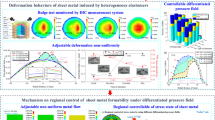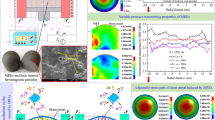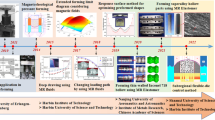Abstract
Plastic deformation of the sheet metal occurs synchronously with elastic deformation of the elastomer in flexible die forming process using elastic die. Thus, adjusting elastic deformation state of the elastomer to adapt to stress state of the sheet metal may be a potential way to improve sheet-forming capability. In this work, various deformation modes of the flexible dies were established using elastomers with different structures, which aims at developing a new way to improve sheet-forming capability through controlling in-plane stress state of the sheet metal. Digital image correlation (DIC) technique was used to capture the displacement and strain field of the sheet metal in bulge tests. Finite element analysis (FEA) was conducted to obtain pressure field of the flexible die and in-plane stresses of the sheet metal. The results showed that forming load, bulged height, and bulge strain could be adjusted by using flexible dies with different structures. The sharp increase of normal pressure in local region at the flexible die/sheet interface leads to non-uniform distribution of radial and circumferential stresses of the sheet metal. A design strategy of flexible die with a hollow structure (i.e., type 6) was proposed to reduce localization of interfacial normal pressure. Due to evenly-distributed normal pressure and beneficial friction at the flexible die/sheet interface, radial and circumferential stresses subjected by the sheet metal were relieved effectively. And the consequent increase of bulge height and bulge strain indicates the improvement of sheet-forming capability.
Graphical Abstract
















Similar content being viewed by others
Availability of data and materials
The manuscript has data included as electronic supplementary material, which can be provided on demand.
Code availability
Not applicable.
References
Koubaa S, Belhassen L, Wali M, Dammak F (2017) Numerical investigation of the forming capability of bulge process by using rubber as a forming medium. Int J Adv Manuf Technol 92:1839–1848
Bell C, Corney J, Zuelli N, Savings D (2020) A state of the art review of hydroforming technology. Int J Mater Form 13:789–828
Maeno T, Mori K, Adachi K (2014) Gas forming of ultra-high strength steel hollow part usingair filled into sealed tube and resistance heating. J Mater Process Technol 214:97–105
Belhassen L, Koubaa S, Wali M, Dammak F (2019) Experimental and numerical investigation of flexible bulging process of aluminum AA1050-H14 sheet metal with soft tools. Int J Adv Manuf Technol 103:4837–4846
Belhassen L, Koubaa S, Wali M, Dammak F (2016) Numerical prediction of springback and ductile damage in rubber-pad forming process of aluminum sheet metal. Int J Mech Sci 117:218–226
Xu J, Zhang J, Cui J, Zhang X (2018) Characteristics of drawing process of AA5182 aluminum alloy sheet during rubber-pad forming. Int J Adv Manuf Technol 96:1139–1148
Younis KM, Aljarjary AI, Shukur JJ (2019) Numerical and experimental investigation of parameters affect the forming load during rubber pad sheet metal forming. Mater Sci Eng 518:32049
Younis KM, Aljarjary AI, Shukur JJ (2019) Analysis of filling capacity during rubber pad sheet metal forming process. Int J Res 6:384–389
Shen Z, Liu H, Wang X, Wang C (2016) Improving the forming capability of laser dynamic forming by using rubber as a forming medium. Appl Surf Sci 369:288–298
Nagarajan B, Castagne S, Wang Z, Zheng HY, Nadarajan K (2017) Influence of plastic deformation in flexible pad laser shock forming-experimental and numerical analysis. Int J Mater Form 10:109–123
Said LB, Wali M, Khedher N, Kessentini A, Algahtani A, Dammak F (2020) Efficiency of rubber-pad cushion in bending process of a thin aluminum sheet. J Rubber Res 23:89–99
Chen L, Chen H, Guo W, Chen G, Wang Q (2014) Experimental and simulation studies of springback in rubber forming using aluminium sheet straight flanging process. Mater Des 54:354–360
Chen L, Chen H, Wang Q, Li Z (2015) Studies on wrinkling and control method in rubber forming using aluminium sheet shrink flanging process. Mater Des 65:505–510
Niknejad A, Shahidi J (2016) Experimental study on cold metal shaping of circular tube into a structural profile and analytical calculation of its forming energy. Int J Adv Manuf Technol 86:1181–1200
Elghawail A, Essa K, Abosaf M, Tolipov A, Su S, Pham D (2019) Low-cost metal-forming process using an elastic punch and a reconfigurable multi-pin die. Int J Mater Form 12:391–401
Hassan MA, Hino K, Takakur K, Yamaguchi K (2002) Friction aided deep drawing of sheet metals using polyurethane ring and auxiliary metal punch. Part 2: analysis of the drawing mechanism and process parameters. Int J Mach Tools Manuf 42:633–642
Sun Y, Wan M, Wu X (2012) Friction coefficient in rubber forming process of Ti-15-3 alloy. Trans Nonferrous Met Soc China 22:2952–2959
Lee J, Park H, Kim S, Kwon Y, Kim D (2018) Numerical investigation into plastic deformation and failure in aluminum alloy sheet rubber-diaphragm forming. Int J Mech Sci 142–143:112–120
Elyasi M, Ghadikolaee HT, Hosseinzadeh M (2017) Fabrication of metallic bipolar plates in PEM fuel cell using semi-stamp rubber forming process. Int J Adv Manuf Technol 92:765–776
Jin CK, Jeong MG, Kang CG (2014) Fabrication of titanium bipolar plates by rubber forming and performance of single cell using TiN-coated titanium bipolar plates. Int J Hydrogen Energy 39:21480–21488
Lee KH, Jin CK, Kang CG, Seo HY, Kim JD (2015) Fabrication of titanium bipolar plates by rubber forming process and evaluation characteristics of TiN coated titanium bipolar plates. Fuel Cells 15:170–177
Iorio L, Pagani L, Strano M, Monno M (2016) Design of deformable tools for sheet metal forming. J Manuf Sci Eng 138:094701
Kuo CC, Li MR (2016) A cost-effective method for rapid manufacturing sheet metal forming dies. Int J Adv Manuf Technol 85:2651–2656
Jarraya A, Kammoun-Kallel I, Dammak F (2011) Theory and finite element implementation of orthotropic and transversely isotropic incompressible hyperelastic membrane. Multidiscip Model Mater Struct 7:424–439
Funding
The presented investigations have been supported by the National Natural Science Foundation of China (No.51905156 and No.51805309) and the fellowship of China Postdoctoral Science Foundation (No. 2020M672221). The authors kindly acknowledge these supports.
Author information
Authors and Affiliations
Contributions
XIANG Nan: Conceptualization, methodology, writing-original draft, and funding acquisition; HUANG Tao: Formal analysis and data curation; WANG Pengyi: Investigation and funding acquisition; ZHENG Li-huang: Formal analysis and data curation; GUO Jun-qing: Visualization; GUO Xiu-hua: Writing-review and editing; CHEN Fuxiao: Project administration. The authors read and approved the final manuscript.
Corresponding authors
Ethics declarations
Ethics approval
Not applicable.
Consent to participate
All the authors listed agree to participate in this work. All the authors listed have approved the manuscript that is enclosed.
Consent for publication
All the authors listed agree to publish this paper. The work described was original research that has not been published previously, and not under consideration for publication elsewhere, in whole or in part.
Conflict of interest
The authors declare that they have no conflict of interest.
Additional information
Publisher's Note
Springer Nature remains neutral with regard to jurisdictional claims in published maps and institutional affiliations.
Rights and permissions
About this article
Cite this article
Xiang, N., Huang, T., Wang, Py. et al. Increased sheet-forming capability via controlling in-plane stress state of the sheet metal using hetero-structured flexible dies. Int J Adv Manuf Technol 120, 3491–3506 (2022). https://doi.org/10.1007/s00170-022-08940-8
Received:
Accepted:
Published:
Issue Date:
DOI: https://doi.org/10.1007/s00170-022-08940-8




